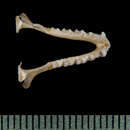en
names in breadcrumbs


There are six subspecies of R. ferrumequinum: R.f. ferrumequinum, R.f. creticus, R.f. proximus, R.f. tragatus, and R.f. nippon. They are found in Europe and northwestern Africa, Crete, southwestern Asia to Kashmir, northern India and southwestern China, and northern and central China, Korea and Japan, respectively (Koopman, 1994).
Perception Channels: tactile ; chemical
Rhinolophus ferrumequinum are threatened in western Germany and Austria. Because R. ferrumequinum are sensitive to human disturbances, a special effort has to be made to protect the roosts and to lower the amount of insecticides used on crops in western Germany and Austria. The insecticides kill R. ferrumequinum prey, thus destroying their only food source (Nowak, 1994), as well as harming the bats themselves
US Migratory Bird Act: no special status
US Federal List: no special status
CITES: appendix iii
IUCN Red List of Threatened Species: least concern
Positive Impacts: controls pest population
Rhinolophus ferrumequinum hunt at nightfall. This species is an insectivore and preys primarily on larger insects such as Lepidoptera (butterflies and moths) and Coleoptera (beetles) (Jones, 1990). In order to obtain their prey, hunting bats fly close to the ground surface (Schober and Grimmberger, 1997). Rhinolophus ferrumequinum does not hunt in the winter unless the air temperature is warm enough for insect flight, and as a result they hunt less during colder and inclement weather (Racey, 1982). Like other microchiropteran bat species, R. ferrumequinum use echolocation to locate their prey. This species emits a call consisting of short blasts at a low frequency (77-81 kHz) (Schober and Grimmberger, 1997). The call is emitted from the nose, not the mouth (Nowak, 1994).
Animal Foods: insects
Primary Diet: carnivore (Insectivore )
Rhinolophus ferrumequinum are found in northern India, south to northwestern Africa and throughout temperate Eurasia including Great Britain and Japan
(Koopman, 1994). They are also found throughout Turkey, Israel and Jordan (DeBlase, 1980)
Biogeographic Regions: palearctic (Native )
Rhinolophus ferrumequinum prefer to dwell in karst caves and cave-like spaces under boulders year-round (DeBlase, 1980). In the winter, R. ferrumequinum roost in caves warmer then 7-10 degrees Celsius. This species prefers warmer regions, which have water, shrubs and trees (Schober and Grimmberger, 1997).
Habitat Regions: temperate ; terrestrial
Terrestrial Biomes: forest
Lifespan/ Longevity: The oldest recorded age of an R. ferrumequinum is 30 years (Schober and Grimmberger, 1997)
Range lifespan
Status: wild: 30 (high) years.
Average lifespan
Status: wild: 30.0 years.
Rhinolophus ferrumequinum is the largest horseshoe bat in Europe (Schober and Grimmberger, 1997). Its most distinctive feature is the upper saddle process or noseleaf, the upper part of which is pointed while the lower part is horseshoe shaped (Nowak, 1994). Tooth and bone structures distinguish R. ferrumequinum from other rhinolophids. The first premolar on the upper jaw protrudes from the row of teeth. Often this premolar is very small or non-existent. The third and fourth metacarpal bones in the wings are shorter than those of its relatives (Koopman, 1994). The tragus is absent (Simmons and Conway, 1997). The length of the head and body ranges from 57 to 71mm, the tail length ranges from 35 to 43 mm and the forearm from 54 to 61 mm. The wing span ranges from 350 to 400 mm, and the weight from 17 to 34 grams. The Greater horseshoe bat can also be identified by its color. The back is brownish gray with a slight tint of red, while the underside is a lighter gray color. The membrane that connects the forearm and tail is brownish gray. Young R. ferrumequinum are uniformly gray. (Schober and Grimmberger, 1997)
Range mass: 17 to 34 g.
Range length: 57 to 71 mm.
Range wingspan: 350 to 400 mm.
Other Physical Features: endothermic ; bilateral symmetry
Females are not sexually mature until their third year, while males are sexually reproductive at age two. Females often do not have young until their fifth year (Racey,1982). Mating usually occurs in the fall but can also occur in the spring (Rossiter et al. 2000). Fertilization does not take place until later and is controlled by the females (Schober and Grimmberger, 1997). After mating, the vagina of Rhinolophus ferrumequinum females is closed by a vaginal plug secreted by the male. It is speculated that the plug is used to keep unwanted sperm out, as a method of mate selection (Fenton, 1984) or to hold the sperm until fertilization in the spring (Rossiter et al., 2000). Female R. ferrumequinum return to the same roosting area year after year to give birth and care for their young.
Average number of offspring: 1.
Average weaning age: 8 weeks.
Range age at sexual or reproductive maturity (female): 2 to 5 years.
Average age at sexual or reproductive maturity (female): 3 years.
Range age at sexual or reproductive maturity (male): 2 to 5 years.
Average age at sexual or reproductive maturity (male): 3 years.
Key Reproductive Features: seasonal breeding ; gonochoric/gonochoristic/dioecious (sexes separate); sexual ; fertilization (Internal ); sperm-storing ; delayed fertilization
Average birth mass: 5.8 g.
Average gestation period: 80 days.
Average number of offspring: 1.
A female produces one baby which is typically born during June or July (Schober and Grimmberger, 1997). Young open their eyes at 7 day and can fly during the third to fourth week. After seven to eight weeks, young are ready to leave the roost. Females form maternity roosts in warmer places such as attics to care for the young (Schober and Grimmberger, 1997). Greater horseshoe bats lose their milk teeth before birth (Nowak, 1994).
Parental Investment: altricial ; female parental care